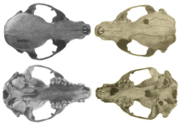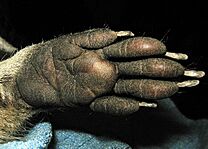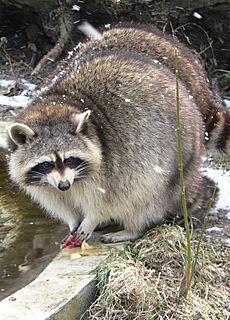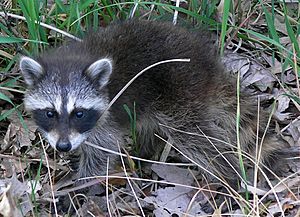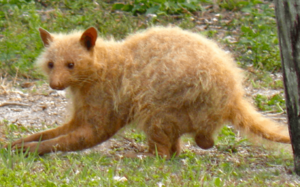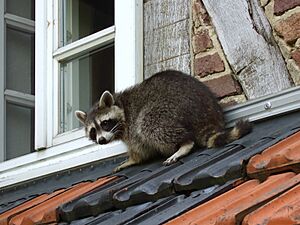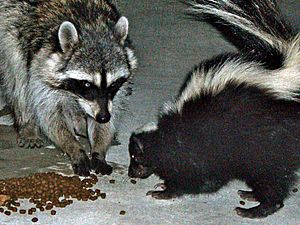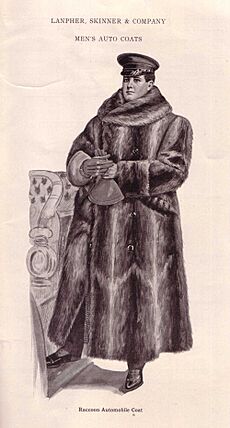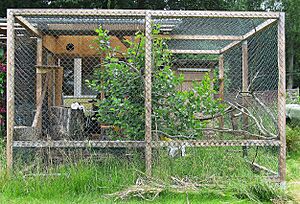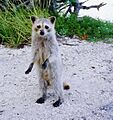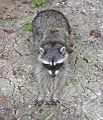Raccoon facts for kids
Quick facts for kids Raccoon |
|
|---|---|
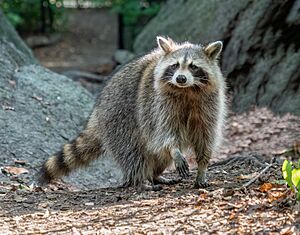 |
|
| Eastern raccoon (P. l. lotor), Central Park in New York City | |
| Conservation status | |
| Scientific classification | |
| Genus: |
Procyon
|
| Species: |
lotor
|
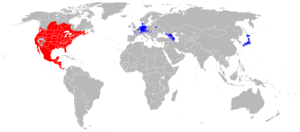 |
|
| Native range in red, introduced range in blue | |
| Synonyms | |
|
|
The raccoon (scientific name: Procyon lotor) is a clever mammal native to North America. People sometimes call it the North American, northern, or common raccoon. This helps tell it apart from other types of raccoons. It is the largest animal in the procyonid family.
Raccoons are about 40 to 70 centimeters long, not counting their bushy tail. They usually weigh between 5 and 26 kilograms. Their fur is mostly grayish and very thick. This dense fur keeps them warm in cold weather. Raccoons are known for their very skilled front paws, their bandit-like facial mask, and their ringed tail. These features often appear in stories from Indigenous peoples of the Americas. Raccoons are quite smart and can remember how to solve puzzles for at least three years. They are usually active at night (nocturnal) and eat many different things (omnivorous). Their diet includes insects, plants, and small animals.
Raccoons originally lived in deciduous and mixed forests. But they are very adaptable! They have spread to mountains, coastal marshes, and even urban areas. In cities, some people see them as a nuisance. Raccoons have also been introduced to central Europe, the Caucasus, and Japan. This happened when some escaped or were released in the mid-1900s. In Europe, raccoons are now considered an invasive species. This means they cannot be imported or released in the European Union.
Scientists used to think raccoons were mostly solitary animals. Now, we know they have interesting social lives. Related female raccoons often share a common area. Unrelated males sometimes live in small groups of up to four. This helps them protect their territory during mating season. A female raccoon's home range in cities can be as small as 3 hectares. For males in prairies, it can be as large as 5000 hectares. After about 65 days, a mother raccoon gives birth to two to five babies, called "kits." She raises them until they are ready to live on their own in the fall. In zoos, raccoons can live over 20 years. But in the wild, they usually live only 1.8 to 3.1 years. Sadly, many raccoons die from hunting or being hit by cars.
Contents
What's in a Name? The Raccoon's Story
The name "raccoon" comes from the Powhatan language. It means 'animal that scratches with its hands'. Early English settlers in Virginia heard this name and started using it. The word is sometimes spelled "racoon."
In Spanish, the raccoon is called mapache. This name comes from the Nahuatl language of the Aztecs. It means 'the one who takes everything in its hands'.
The raccoon's scientific name is Procyon lotor. Procyon means 'before-dog' or 'doglike'. Lotor is Latin for 'washer'. This name comes from the raccoon's habit of "washing" its food. For example, in French, it's called raton laveur, which means 'washing rat'.
You might hear the short word "coon" in old stories or songs. This word was once used for raccoons and in phrases like "coonskin cap." However, it became a very offensive term, especially in the late 1800s and early 1900s. Today, it is still considered a hurtful and inappropriate word. Dogs bred to hunt raccoons are called coonhounds. Because raccoons often eat human garbage in cities, some people jokingly call them "trash pandas."
Raccoon Family Tree: Taxonomy and Evolution
When Europeans first discovered raccoons, scientists weren't sure how to classify them. They thought raccoons might be related to dogs, cats, badgers, or even bears. Carl Linnaeus, who created the modern system for naming animals, first placed raccoons with bears. Later, in 1780, another scientist named Gottlieb Conrad Christian Storr gave the raccoon its own group, Procyon.
How Raccoons Evolved Over Time
The earliest known relatives of raccoons lived in Europe about 25 million years ago. Scientists believe that these early relatives crossed into North America much later. The common raccoon's ancestors moved north about 2.5 million years ago. Fossils found in the Great Plains support this idea.
Different Types of Raccoons: Subspecies
There are 22 recognized subspecies of raccoons. Subspecies are like different varieties within the same animal species. Some of these subspecies live on small islands in Central America and the Caribbean. For example, the Bahamian raccoon and the Guadeloupe raccoon are island subspecies. The Cozumel raccoon, found on Cozumel Island, is considered a separate species because it is much smaller and has tiny teeth.
Most other subspecies have only small differences in fur color or size. The two most common subspecies are the eastern raccoon and the Upper Mississippi Valley raccoon. The eastern raccoon lives in many eastern U.S. states and Canadian provinces. The Upper Mississippi Valley raccoon covers a large area to the west.
Raccoon Features: What Do They Look Like?
Body and Appearance
From head to rear, raccoons are about 40 to 70 centimeters long. Their bushy tail adds another 20 to 40 centimeters. An adult raccoon's weight can vary a lot, from 2 to 26 kilograms. However, they usually weigh between 5 and 12 kilograms. Raccoons in southern Florida are often the smallest. Those in colder northern areas tend to be the largest. Males are typically 15 to 20% heavier than females. Before winter, a raccoon can double its weight by storing fat.
The most recognizable feature is the black fur around their eyes. This "bandit's mask" stands out against their white face. Their rounded ears also have white fur borders. This mask might help raccoons recognize each other. It may also help reduce glare, improving their night vision. Their body fur is usually gray, sometimes with brown shades. The thick underfur, about 2 to 3 centimeters long, keeps them warm.
Raccoons usually walk on all fours, like bears. They can stand on their hind legs to use their front paws to examine things. Raccoons have short legs, so they aren't very fast runners. Their top speed is about 16 to 24 kilometers per hour. They are good swimmers, moving at about 5 kilometers per hour. They can stay in water for hours. Raccoons can even climb down trees headfirst! They do this by rotating their hind feet backward.
Raccoon skulls have a short, wide face and a large braincase. They have 40 teeth, suited for their varied diet. Their teeth are not as sharp as a full-time meat-eater's. But they are not as wide as a plant-eater's either. This helps them eat both plants and animals.
Amazing Senses: Touch, Sight, Smell, and Hearing
A raccoon's most important sense is its sense of touch. Their front paws are super sensitive. A thin, hard layer protects them, which softens when wet. The five digits on their paws have no webbing, which is unusual for a meat-eating animal. Almost two-thirds of the raccoon's brain area for senses is dedicated to touch. They can identify objects with whiskers above their claws before even touching them. Raccoons cannot move their thumbs to grasp things like humans do.
Raccoons might be colorblind or see colors poorly. However, their eyes are good at seeing green light. They see well in dim light because of a special reflective layer behind their retina. But their long-distance vision isn't great. Their sense of smell is also very important. They use scent marks from glands, urine, and feces to communicate with other raccoons. Raccoons have excellent hearing. They can hear very high-pitched sounds and even quiet noises, like earthworms moving underground.
How Smart Are Raccoons?
Zoologist Clinton Hart Merriam called raccoons "clever beasts." He said their cunning was sometimes greater than a fox's. Studies show how smart they are. In one study from 1908, raccoons could open 11 out of 13 complex locks. They did this in fewer than 10 tries. They also remembered how to do it even when the locks were changed. This suggests they understood how the locks worked.
Other studies showed raccoons can remember solutions to tasks for at least three years. In 1992, raccoons could tell the difference between identical and different symbols. They remembered this three years after learning it. Scientists have also found that raccoons have a high density of neurons in their brain. This is similar to some primates and suggests high intelligence.
Raccoon Life: Behavior and Habits
Social Life of Raccoons
Recent studies show that raccoons are not always solitary. They have specific social behaviors. Related female raccoons often share a common area. They might meet at feeding spots or resting places. Unrelated male raccoons sometimes form small groups of up to four. This helps them protect their territory from other males, especially during mating season.
Mothers usually keep their young kits away from other raccoons. This is until the kits are big enough to defend themselves. Because of these different ways of living, one scientist called their social structure a "three-class society."
A raccoon's home range size changes based on its age, sex, and where it lives. Adults usually have areas twice as large as young raccoons. In prairies, male home ranges can be 7 to 50 square kilometers. Female ranges are 2 to 16 square kilometers. In marshy areas, the average size was 0.5 square kilometers. Raccoons mark their territories with scents. They also use shared "raccoon latrines" (places where they leave urine and feces). These spots might share information about food.
What Raccoons Eat: Their Diet
Raccoons are usually active at night, but they sometimes look for food during the day. They eat a very wide variety of foods. About 40% of their diet is invertebrates (like insects and worms). About 33% is plant material (like fruits and nuts). The remaining 27% is vertebrates (small animals). This makes them one of the most omnivorous animals in the world.
In spring and early summer, they mostly eat insects and worms. Later in summer and autumn, they prefer fruits and nuts like acorns and walnuts. These foods give them lots of calories to build up fat for winter. Raccoons rarely hunt large animals. They prefer easier prey like crayfish, fish, amphibians, and bird eggs. They are known for eating eggs and hatchlings from bird and reptile nests. In colder northern areas, raccoons rest during winter when snow makes finding food hard.
Why Raccoons "Wash" Their Food
One famous raccoon behavior is "washing" its food. This is why its scientific name, Procyon lotor, includes lotor, which means 'washer'. In the wild, raccoons often search for food underwater near shorelines. They pick up food with their front paws to examine it. They might rub the food, sometimes to remove unwanted parts. This looks like they are "washing" it. The water also makes their sensitive paw pads even more touchy.
However, raccoons in zoos often carry their food to water to "wash" it before eating. This behavior is not usually seen in the wild. Scientists believe this "dousing" in captive raccoons is a natural instinct. It comes from their habit of searching for aquatic foods. They are not actually cleaning dirty food.
Raccoon Reproduction and Life Cycle
Raccoons usually mate between late January and mid-March. This timing can vary by region. During mating season, males travel widely to find females. They try to court females during the few days when they can become pregnant. Mating can last over an hour and happen over several nights.
After about 63 to 65 days, a mother raccoon gives birth to a litter of two to five young. These babies are called "kits" or "cubs." The average litter size depends on the habitat. Larger litters are more common where more young raccoons die. Male raccoons do not help raise the young. Kits are born blind and deaf, but their mask is already visible. They weigh about 60 to 75 grams and are about 10 centimeters long. Their ears open after 18 to 23 days, and their eyes open a few days later.
When kits weigh about 1 kilogram, they start exploring outside the den. They begin eating solid food after six to nine weeks. Their mother nurses them less often, and they are usually weaned by 16 weeks. In the fall, the young raccoons leave their mother. Many females stay near their mother's home range. Males might move more than 20 kilometers away. This helps prevent inbreeding. In cold areas, mothers and offspring might share a den during their first winter.
How Long Do Raccoons Live?
Raccoons in zoos have lived for over 20 years. But in the wild, their life expectancy is only 1.8 to 3.1 years. This depends on things like traffic, hunting, and severe weather. Often, only half of the kits born in a year survive their first year. After that, the yearly death rate drops.
The most common natural cause of death for North American raccoons is distemper. This disease can spread quickly and kill many raccoons in an area. In places with lots of cars and hunting, these can cause up to 90% of adult raccoon deaths. Natural predators like bobcats, coyotes, and great horned owls also hunt raccoons, especially the young. In some areas, larger predators like American black bears, cougars, and American alligators might also prey on them.
Where Raccoons Live: Their Range
Raccoon Habitats
Raccoons need places to climb when they feel threatened. So, they avoid wide-open areas. They also avoid areas with many beech trees, as the bark is too smooth to climb. They prefer tree hollows in old oaks or rock crevices for sleeping, winter dens, and raising young. If these aren't available, they use burrows dug by other animals or dense bushes.
Raccoons love areas with water, like lowland deciduous or mixed forests with many rivers and marshes. This is because amphibians, crustaceans, and other water animals are a big part of their diet. These watery areas have the highest raccoon populations.
Raccoon Distribution in North America
Raccoons are found all over North America, from Canada to Panama. In the past, raccoons were mainly found along rivers and in the woodlands of the Southeastern United States. Since the 1950s, they have spread widely. They now live in northern Canada, mountains, prairies, and coastal marshes.
After a big population increase starting in the 1940s, the number of raccoons in North America grew a lot. By the late 1980s, there were 15 to 20 times more raccoons than in the 1930s. This increase is likely due to cities growing, more farming, raccoons being introduced to new areas, and fewer natural predators.
Raccoons Around the World
Raccoons are now found in several European and Asian countries. This happened because some escaped or were intentionally released in the mid-1900s. Germany has the largest raccoon population outside of North America. There is also a stable population in northern France. Raccoons have also been seen around Madrid in Spain since the 1970s. In 2013, the city allowed their capture and removal. They are also present in Italy.
About 1,240 raccoons were released in the former Soviet Union between 1936 and 1958. This was done to establish a population for fur hunting. Two of these introductions were successful, one in Belarus and another in Azerbaijan. By 1974, the estimated population in the Caucasus region was around 20,000 animals.
Raccoons in Japan
In Japan, many raccoons were imported as pets after a popular anime series called Rascal the Raccoon in 1977. By 2004, the descendants of escaped or discarded pets lived in 42 of Japan's 47 prefectures. By 2008, they were in all 47 prefectures. Raccoons cause significant damage to farms in Japan.
Raccoons in Germany
In Germany, raccoons are called Waschbär, meaning 'wash-bear'. In April 1934, two pairs of pet raccoons were released into the German countryside near the Edersee reservoir. A second population started in eastern Germany in 1945. This happened when 25 raccoons escaped from a fur farm after an air strike.
By 1956, there were an estimated 285 raccoons in the Hessian region. This number grew to over 20,000 by 1970. By 2008, there were between 200,000 and 400,000 raccoons in all of Germany. By 2012, estimates suggested over a million raccoons. Raccoons are now hunted in Germany because they are seen as an invasive species and a nuisance. The number of raccoons hunted each year has increased dramatically.
Raccoons in Cities
Raccoons have adapted well to living in urban areas. The first sightings in cities were in the 1920s in Cincinnati. Since the 1950s, raccoons have been common in big cities like Washington, D.C., Chicago, Toronto, and New York City. Since the 1960s, Kassel, Germany, has had Europe's first and densest urban raccoon population.
Urban raccoons have smaller home ranges. They find easy food sources like fruit and insects in gardens, and leftovers in trash cans. They also find many places to sleep, such as hollows in old garden trees, sheds, garages, abandoned houses, and attics.
Raccoon Health and Safety
Raccoons can carry rabies, a very serious disease caused by a virus. It spreads through bites and affects the brain. The spread of raccoon rabies began in Florida and Georgia in the 1950s. In 2006, raccoons accounted for a large percentage of reported rabies cases in the United States. Health authorities use oral vaccination programs to help control the disease.
It's important to stay away from any wild animal that looks sick or acts strangely. Rabid raccoons might look unwell, move oddly, make strange sounds, or be aggressive. However, some might not show any clear signs. Healthy raccoons, especially mothers, sometimes look for food during the day. So, seeing a raccoon during the day doesn't always mean it's sick. If you see an animal acting unusually, tell your local animal control or health department.
Another common disease for raccoons is distemper. This virus does not affect humans. It is a frequent natural cause of death for raccoons. Distemper can cause symptoms similar to rabies.
Raccoons can also carry bacteria like leptospirosis and tetanus. They can also have internal parasites, such as the roundworm Baylisascaris procyonis. This roundworm can be found in raccoon feces. If humans accidentally swallow or breathe in the eggs, it can cause serious illness. It's important to wear protection when cleaning up raccoon droppings.
Raccoons and People
Dealing with Raccoons in Your Neighborhood
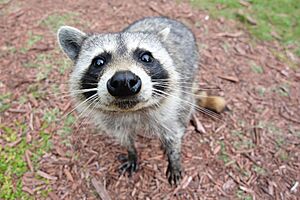
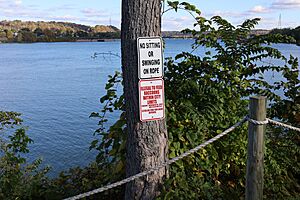
Raccoons are known for getting into food waste in cities. They are very good at solving problems and can open most trash cans. This has earned them the nickname "trash panda." Raccoon droppings can contain parasites and diseases, like the raccoon roundworm. This is why it's important to be careful around them. If you find raccoon droppings in or near your home, they should be removed carefully. The roundworm eggs are tough, so special cleaning methods are needed.
Many experts and authorities advise against feeding wild animals. Feeding them can make them too comfortable around humans. They might become dependent on people for food. Some people worry that raccoons without fear of humans might have rabies. However, scientists say this behavior is usually just raccoons getting used to living near people. Raccoons usually don't attack pets, but rare cases have been reported.
Raccoons can cause damage to homes, especially if they make dens in attics. Loud noises, flashing lights, and strong smells can sometimes scare away a mother and her kits. The best long-term solution is to prevent raccoons from accessing food waste and den sites.
In farm areas, raccoons especially love sweet corn. They can cause a lot of damage to crops. They might also break into chicken coops to eat chickens, ducks, or their eggs.
Raccoons in Stories and Art
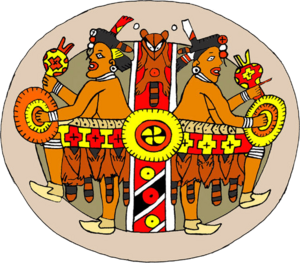
In the mythology of Indigenous peoples of the Americas, raccoons appear in many folk tales. Stories often highlight their foraging skills, like "How raccoons catch so many crayfish." In other tales, the raccoon is a trickster who outsmarts other animals. The Dakota people believe raccoons have special spirit powers. This is because their mask looks like the face paintings used in rituals. The Aztecs linked supernatural abilities to female raccoons. They saw their dedication to their young as similar to wise women in their society.
Raccoons also appear in Native American art. Petroglyphs (rock carvings) of raccoon tracks have been found in places like Texas and Kentucky. The meaning of the Raccoon Priests Gorget, a carving found at the Spiro Mounds in Oklahoma, is still a mystery.
Raccoons and the Fur Trade
Raccoon fur has been used for clothing, such as coats and coonskin caps. Today, it is used for the "sealskin" caps worn by the Royal Fusiliers in Great Britain. Historically, Native American tribes used the fur for winter clothing and tails for decoration. The famous Sioux leader Spotted Tail got his name from a raccoon skin hat.
In the 19th century, many raccoons were hunted for their fur. The number increased when automobile coats became popular in the early 1900s. In the 1920s, wearing a raccoon coat was a sign of status for college students. Attempts to raise raccoons on fur farms were not profitable. After raccoon populations grew in the 1940s, the number of raccoons hunted each season reached millions. The broadcast of TV shows about Davy Crockett in the 1950s led to a high demand for coonskin caps. Today, raccoons are still hunted in some areas, often as part of wildlife management.
Pet Raccoons
Raccoons are sometimes kept as pets. However, many experts advise against this because raccoons are not domesticated animals. They can act unpredictably and aggressively. It is also very hard to teach them to obey commands. In places where keeping raccoons as pets is allowed, you might need a special permit. A famous pet raccoon was Rebecca, kept by U.S. President Calvin Coolidge.
Raccoons are very intelligent and have nimble paws. Even young raccoons can easily open jars, bottles, and door latches. Older raccoons can even open doorknobs. During mating season, adult raccoons can become aggressive. Spaying or neutering them when they are young can help reduce aggressive behavior. Raccoons can also get sick from poor diets or lack of exercise. For example, feeding them cat food for a long time can cause gout. In some countries, like Austria and Germany, laws require keeping at least two raccoons together to prevent loneliness. They are usually kept in a pen, not inside a house, because their natural curiosity can cause damage.
If young kits are orphaned, it is possible to care for them and release them back into the wild. However, it's not certain if they fully adapt to wild life again. It's important to feed unweaned kits special milk, not cow's milk, which can be harmful.
Local and Indigenous Names for Raccoons
| Linguistic group or area | Local / Indigenous name |
|---|---|
| Canadian French | Raton laveur |
| Choco | Touaru |
| Cocopah | NYmaṣ |
| Cree | ᐱᓯᐢᑫᐢ (pisiskês) ᐅᒋᑯᒼᓯᐢ (ocikomsis) |
| Cree (Swampy and Woods) | kimociškw- |
| Creek | Wot•ko |
| Lakota | wičhítegleǧa, wičhá |
| Lenape | Nahënëm |
| Louisiana French | Chaoui |
| Mayan | Culu |
| Mi'kmaq | amaljugwej |
| Miskito | Suksuk |
| Nahuatl | Mapachitli |
| Navajo | Tábąąh mą'ii |
| Nez Perce | K'ayk'áyoc |
| Oglala Lakota | Wee'-cha |
| Ojibwe | Esiban |
| Omaha–Ponca | miká |
| Pawnee | Icat |
| Spanish | Mapache Mapachín Tejón Gato manglatero |
| Wintu | Qari•lit |
| Yankton Dakota | Way-atch-a |
Images for kids
-
A Torch Key raccoon (P. l. incautus) in Cudjoe Key, Florida.
See also
 In Spanish: Mapache boreal para niños
In Spanish: Mapache boreal para niños
- Cozumel raccoon, an endangered species in the Yucatán Peninsula
- Crab-eating raccoon, of Central and South America, eats crustaceans amongst other things
- Raccoon dog, native to East Asia
- Mexican raccoon, native to Mexico and much of Central America






